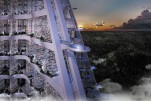Sky Cities: Sustainable Vertical Urbanism of the Future

At the beginning of the XXI century, after the erection of a number of skyscrapers over 500 meter height, several deadlock problems in high-rise construction came to light. They are related to design and technical limitations: vertical transportation, evacuation, fire-fighting and anti-terrorism security of the objects, as well as to the complex logistics of construction operations that affects terms and exorbitant total cost per square meter. It makes such projects isolated, unprofitable, and therefore hopeless from the economic point of view and not energy effective from the technical one.
The reason is that mega towers are in fact just extremely elongated versions of traditional layouts of high-rise buildings with a central core and such a layout has certain limitations. For example, it is impossible now to build an elevator shaft higher than 600 m taking into account design wind-induced building vibrations with an amplitude 1/500-1/1000 of the height. It is not just because of that ropes weigh too much but due to design verticality deviations of shaft walls. With such amplitudes it threats the integrity of the ropes and mechanisms themselves. Complete evacuation from a skyscraper taller than 500 m via two or three stairs is difficult and even impossible for many people. If floors are typical, the average rate of construction is about one floor per week. However, as the height increases, the rate begins to slow down significantly (antigravity solution during the construction is quite expensive!). So, for example, the construction period for a 200-storey mega tall building is not 4 times but even 5-7 times more than that for a 50-storey tower. It means the time of construction is equal to the average payback period of a typical project (7 years). A priori it makes a project unprofitable. Burj Khalifa (Dubai), the highest tower for now, was constructed due to the personal financial sponsorship by Sheikh Khalifa on the one hand, and due to sales of apartments and offices with a view of the tower that are placed in neighboring districts and built by the same developer Emaar on the other hand. As isolated projects skyscrapers are usually unprofitable if consider construction as a business. Further development of buildings taller than 600 m and their technical and financial viability require a completely different building mass concept.
The full version of the article can be read in our printed issue, also you can subscribe to the web-version of the magazine
 Materials provided by GORPROJECT, CJSC
Materials provided by GORPROJECT, CJSC
Text: Philip Nikandrov, Chief Architect of GORPROJECT, CJSC (Moscow – St. Petersburg)


